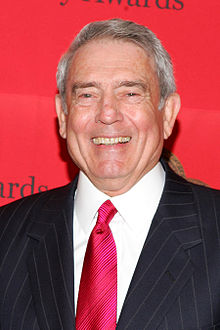
Daniel Irvin "Dan" Rather, Jr. (born October 31, 1931) is an American journalist and the former news anchor for the CBS Evening News. He is now managing editor and anchor of the television news magazine Dan Rather Reports on the cable channel AXS TV. Rather was anchor of the CBS Evening News for 24 years, from March 9, 1981, to March 9, 2005. He also contributed to CBS's 60 Minutes. Rather became embroiled in controversy about a disputed news report involving President George W. Bush's Vietnam-era service in the National Guard and subsequently left CBS Evening News in 2005, and he left the network altogether after 43 years in 2006.
Daniel Irvin Rather, Jr. /ˈræðər/ was born on October 31, 1931 in Wharton County, Texas, the son of Daniel Irvin Rather, Sr., and the former Byrl Veda Page. The Rathers moved to Houston, where Dan attended Love Elementary School and Hamilton Middle School. He graduated in 1950 from John H. Reagan High School in Houston. In 1953, he earned a bachelor's degree in journalism from Sam Houston State University where he was editor of the school newspaper, The Houstonian. At Sam Houston, he was a member of the Caballeros – the founding organization of the currently active Epsilon Psi chapter of the Sigma Chi fraternity. After obtaining his undergraduate degree, Rather briefly attended South Texas College of Law in Houston, which later awarded him an honorary Juris Doctor in 1990. In 1954, Rather enlisted in the United States Marine Corps, but was soon discharged because of having had rheumatic fever as a child.
Rather began his journalism career in 1950 as an Associated Press reporter in Huntsville, Texas. Later, he was a reporter for United Press (1950–1958), several Texas radio stations, and the Houston Chronicle (1954–1955). Around 1955, Rather did a story on heroin. Under the auspices of the Houston Police, he experienced the drug which he characterized as "a special kind of hell."While at Sam Houston State, Rather worked for KSAM-FM radio in Huntsville, Texas, calling junior high, high school, and Sam Houston State football games. He later spent four seasons as the play-by-play announcer for the University of Houston football team. During the 1959 minor league baseball season, Rather was the play-by-play radio announcer for the Houston Buffs team of the triple A American Association. In 1959, he began his television career as a reporter for KTRK-TV, the ABC affiliate in Houston. Rather was subsequently promoted to the director of news for KHOU-TV, the CBS affiliate in Houston. Ray Miller, news director of KPRC-TV, the NBC affiliate in Houston, also mentored Rather in the early years.
In early September 1961, Rather reported live from the Surfside bridge as Hurricane Carla threatened the Texas coastline. In his autobiography, Rather notes that back then, television stations did not have their own radar systems, and there was no modern computerized radar that combines the radar image with an outline map. So he took a camera crew to the U.S. Weather Bureau (National Weather Service) office with a WSR-57 radar console located on the 5th floor of the Post Office Building on 25th Street in downtown Galveston (the antenna and its radome housing were located above the 7th floor, on the roof). A meteorologist drew for him a rough outline of the Gulf of Mexico on a sheet of plastic, and held that over the black and white radar display of Carla to give Rather's audience an idea of Carla's size, and the position of the hurricane's eye. The feat was memorialized by a curbside Texas Historical Marker at the Post Office. Rather's reporting was the first ever display of a meteorological surveillance radar on television, and has been imitated by countless other reporters. This so impressed the network executives at CBS, that they offered him a job as a CBS News correspondent. Rather also, along with numerous other local and national television reporters, showed TV audiences the effects of Carla along the seawall, from the time the storm surge started slowly coming in, through much of the duration, and the aftermath. Rather refused CBS's first offer, but accepted their second offer when it came three months later.
On February 28, 1962, Rather left Houston for New York City for a six-month trial initiation. Rather didn't fit in easily on the East Coast, and his first reports for CBS included coverage of the crash of American Airlines Flight 1 in Jamaica Bay, and a less memorable event on the suffocation of children at a hospital in Binghamton. Shortly after, Rather was made chief of CBS's Southwest bureau in Dallas. In August 1963, he was appointed chief of the Southern bureau in New Orleans, responsible for coverage of news events in the South, Southwest, Mexico and Central America. It would be only a matter of time before Rather reported on the Kennedy assassination.
No comments:
Post a Comment